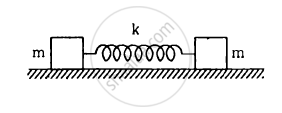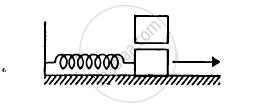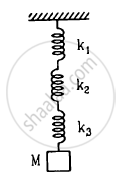Advertisements
Advertisements
प्रश्न
The equation of motion of a particle started at t = 0 is given by x = 5 sin (20t + π/3), where x is in centimetre and t in second. When does the particle
(a) first come to rest
(b) first have zero acceleration
(c) first have maximum speed?
उत्तर
Given:
The equation of motion of a particle executing S.H.M. is,
\[x = 5 \sin \left( 20t + \frac{\pi}{3} \right)\]
The general equation of S..H.M. is give by,
\[x = A \sin (\omega t + \phi)\]
(a) Maximum displacement from the mean position is equal to the amplitude of the particle.
As the velocity of the particle is zero at extreme position, it is at rest.
\[\therefore \text { Displacement }\] x = 5, which is also the amplitude of the particle.
\[\Rightarrow 5 = 5 \sin \left( 20t + \frac{\pi}{3} \right)\]
\[\text { Now }, \]
\[ \sin \left( 20t + \frac{\pi}{3} \right) = 1 = \sin\frac{\pi}{2}\]
\[ \Rightarrow 20t + \frac{\pi}{3} = \frac{\pi}{2}\]
\[ \Rightarrow t = \frac{\pi}{120} s\]
The particle will come to rest at \[\frac{\pi}{120} s\]
(b) Acceleration is given as,
a = ω2x
\[= \omega^2 \left[ 5 \sin \left( 20t + \frac{\pi}{3} \right) \right]\]
For a = 0,
\[5 \sin \left( 20t + \frac{\pi}{3} \right) = 0\]
\[ \Rightarrow \sin \left( 20t + \frac{\pi}{3} \right) = \sin \pi\]
\[ \Rightarrow 20t = \pi - \frac{\pi}{3} = \frac{2\pi}{3}\]
\[ \Rightarrow t = \frac{\pi}{30} s\]
\[\cos \left( 20t + \frac{\pi}{3} \right) = - 1 = \cos \pi\]
\[ \Rightarrow 20t = \pi - \frac{\pi}{3} = \frac{2\pi}{3}\]
\[ \Rightarrow t = \frac{\pi}{30} s\]
APPEARS IN
संबंधित प्रश्न
The pendulum of a clock is replaced by a spring-mass system with the spring having spring constant 0.1 N/m. What mass should be attached to the spring?
In following figure k = 100 N/m M = 1 kg and F = 10 N.
- Find the compression of the spring in the equilibrium position.
- A sharp blow by some external agent imparts a speed of 2 m/s to the block towards left. Find the sum of the potential energy of the spring and the kinetic energy of the block at this instant.
- Find the time period of the resulting simple harmonic motion.
- Find the amplitude.
- Write the potential energy of the spring when the block is at the left extreme.
- Write the potential energy of the spring when the block is at the right extreme.
The answer of b, e and f are different. Explain why this does not violate the principle of conservation of energy.

Repeat the previous exercise if the angle between each pair of springs is 120° initially.
Find the elastic potential energy stored in each spring shown in figure, when the block is in equilibrium. Also find the time period of vertical oscillation of the block.
Consider the situation shown in figure . Show that if the blocks are displaced slightly in opposite direction and released, they will execute simple harmonic motion. Calculate the time period.

A rectangle plate of sides a and b is suspended from a ceiling by two parallel string of length L each in Figure . The separation between the string is d. The plate is displaced slightly in its plane keeping the strings tight. Show that it will execute simple harmonic motion. Find the time period.

A 1 kg block is executing simple harmonic motion of amplitude 0.1 m on a smooth horizontal surface under the restoring force of a spring of spring constant 100 N/m. A block of mass 3 kg is gently placed on it at the instant it passes through the mean position. Assuming that the two blocks move together, find the frequency and the amplitude of the motion.

Find the elastic potential energy stored in each spring shown in figure when the block is in equilibrium. Also find the time period of vertical oscillation of the block.

Show that for a particle executing simple harmonic motion.
- the average value of kinetic energy is equal to the average value of potential energy.
- average potential energy = average kinetic energy = `1/2` (total energy)
Hint: average kinetic energy = <kinetic energy> = `1/"T" int_0^"T" ("Kinetic energy") "dt"` and
average potential energy = <potential energy> = `1/"T" int_0^"T" ("Potential energy") "dt"`
When a particle executing S.H.M oscillates with a frequency v, then the kinetic energy of the particle?
When the displacement of a particle executing simple harmonic motion is half its amplitude, the ratio of its kinetic energy to potential energy is ______.
A body is executing simple harmonic motion with frequency ‘n’, the frequency of its potential energy is ______.
A body is executing simple harmonic motion with frequency ‘n’, the frequency of its potential energy is ______.
A body is executing simple harmonic motion with frequency ‘n’, the frequency of its potential energy is ______.
A body is performing S.H.M. Then its ______.
- average total energy per cycle is equal to its maximum kinetic energy.
- average kinetic energy per cycle is equal to half of its maximum kinetic energy.
- mean velocity over a complete cycle is equal to `2/π` times of its π maximum velocity.
- root mean square velocity is times of its maximum velocity `1/sqrt(2)`.
Draw a graph to show the variation of P.E., K.E. and total energy of a simple harmonic oscillator with displacement.
Find the displacement of a simple harmonic oscillator at which its P.E. is half of the maximum energy of the oscillator.
A particle undergoing simple harmonic motion has time dependent displacement given by x(t) = A sin`(pit)/90`. The ratio of kinetic to the potential energy of this particle at t = 210s will be ______.
The total energy of a particle, executing simple harmonic motion is ______.
where x is the displacement from the mean position, hence total energy is independent of x.
